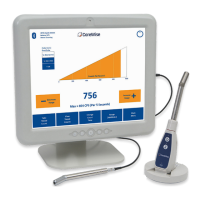INSTRUCTIONS
Initial treatment at
the point of use
No initial treatment at the point of use is required.
Preparation before cleaning The OmniProbe’s collimator (standard or Lechner) should be removed
prior to cleaning and cleaned separately.
The probe cable (when fitted) should also be removed prior to cleaning and cleaned separately.
Cleaning: Automated Automated cleaning should not be performed on the device.
Cleaning: Manual 1) Routine Cleaning
The Apollo device and accessories should be regularly cleaned to prevent build-up of dirt and
detritus. To clean the device, ensure it is switched o and wipe gently with a non-abrasive cloth
with a mild detergent or IPA solution (70% v/v). When Cleaning the Omniprobe, make sure
to remove the collimator and clean the nosepiece.
Note: Do not use any cleaning solution on any connector or ports. Ensure the device is fully dry
before use or reconnecting any accessory or probe. Refer to the warnings section above.
2) Cleaning to remove potential radioactive contamination
Potential contamination from radioactive material will be indicated by an increased in the
measured background count rate (i.e. with no radioisotope in the region of the probe).
a) Remove the sterile drape from the probe – the background count rate
should return to normal levels (no greater than 1-2 cps).
b) If, after removing the sterile drape from the probe, the system still
indicates a high background, shut down the system.
c) Use a disposable pan or vessel to contain the liquid required to complete the cleaning process
The liquid, disposal wipes, and any other material that will contact the liquids used in the
decontamination process must be assumed to be radioactive. These materials and liquids
must be handsetd and disposed of as per your institution’s licence agreements with, national,
state or federal regulatory agencies. Consult with your radiation safety ocer for guidance.
d) Use a commercially-available decontaminating product (e.g. Bind-It™ Radioactive
Decontamination products) to clean the probe. Rinse the probe several times
with distilled water.
Note: Make certain that the connector within the distal end of the probe handset is absolutely
dry before inserting the cable connector into the probe handset. Never immerse the connector
ends of the probe cable in liquid.
Processing Instructions in accordance with ISO 17664:2017, Annex B
Manufacturer: Southern Scientific Limited
Device: Care Wise C-Trak
®
OmniProbes (Standard, EL and PET; standard and Lechner collimators)
WARNINGS OmniProbes sold with the C-Trak system are sold as non-sterile devices and must always
be used within a sterile drape. Sterilisation of the OmniProbes is possible, but optional,
and can be used as an extra precaution if necessary; please see further information
regarding the validated sterilisation methods in the table below.
DO NOT AUTOCLAVE the gamma probe (OmniProbe). Steam or dry heat sterilisation
will damage the gamma probe and cable, void the warranty and could result in
injury to the operator or patient.
DO NOT IMMERSE the analyser control unit or cable connections in liquids.
The Apollo wireless handset MUST be used within a suitable sterile sheath/drape.
Only the OmniProbe and associated coaxial cable can be processed according
to the instructions defined below.
DO NOT process the Apollo wireless handset.
Limitations on processing There are no known restrictions on number of processing cycles.
24
|
www.carewise.com
C-Trak Apollo
5.0 Sterile Practices, Cleaning and Disinfecting

